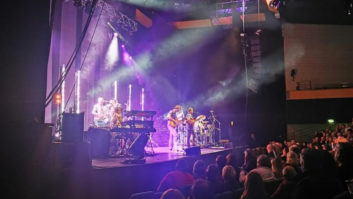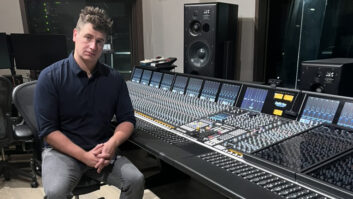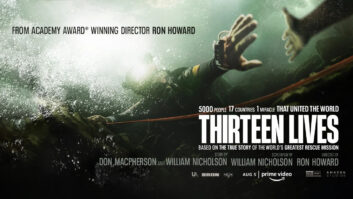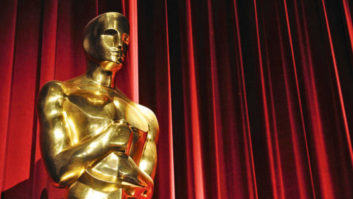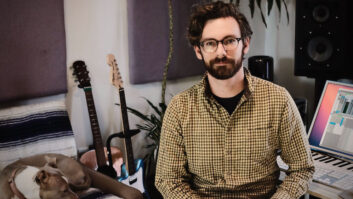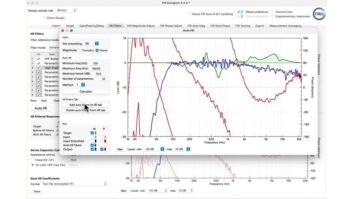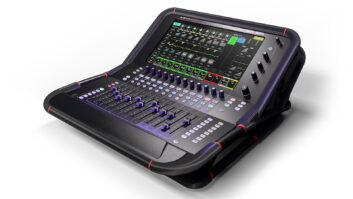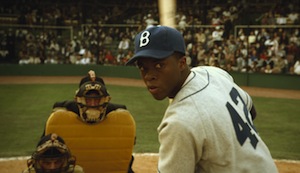
Photo: Courtesy of Warner Bros. Pictures
When Jackie Robinson took the field as the first African-American baseball player in the major leagues in 1947, it was a momentous event in baseball—and American—history. Moviegoers reliving that moment in director Brian Helgeland’s April release, 42 (Warner Bros.), will get a little extra push from composer Mark Isham into how they perceive Robinson’s experience.
“I never like to overplay anything or manipulate an audience with music,” the composer tells Mix. “I like to feel the audience is with me, maybe ahead of me. I’m just supporting what they’re feeling, goosing them just a touch, so that they never even realize it.”
For the film, Isham created a near-minimal score (appropriately, 42 minutes’ worth) based on, and recorded with, an old-school approach. “I was looking for an old-fashioned score, certainly orchestral, with a recurring theme,” Helgeland says. “I’ve always found Mark’s music both masculine and very romantic, in the larger sense of the word. We punctuate the action and play the suspense here and there, but I wanted a score that followed Jack Roosevelt Robinson’s journey in the larger sense, and Mark absolutely achieved this.”

Composer Mark Isham
Photo: Ben Ealovega
“It became very clear that the score needed to be old-time filmmaking,” Isham adds. “One that could be very small and very intimate, but then, at the end, rise up to the momentous quality of the way Brian shot the ending.”
Themes for Robinson feature French horns, accented for special moments by a solo trumpet, while those for his wife, Rachel, are based around piano, sometimes augmented by clarinets. The score was recorded in late January by veteran engineer Peter Cobbin at Abbey Road Studios’ Studio One in London. Five sessions were held over two-and-a-half days, mostly with a 50-piece orchestra but sometimes with a 65-piece group brought in for bigger cues. It was mixed shortly thereafter at Studio Santa Barbara in Southern California by mixer Dennis Sands, a longtime Isham collaborator.
While Isham had recorded scores for The Black Dahlia and Rules of Engagement at Abbey Road, he had never worked with Cobbin prior to 42. Isham established early on that he wanted to stick with a traditional live recording, instead of recording in separate groups—something Cobbin welcomed and Sands endorsed.

Peter Cobbin, Mark Isham and orchestrator Brad Dechter
“If you want that really beautiful orchestral sound that gives you size and dimension, you need to record the room,” Sands says. “And in order to do that, you have to be really cognizant of the dynamics of the room. Pete’s been working in Studio One for a very long time—he knows that room. He did a beautiful job.”
Studio One has two qualities that are unique to the studio and help give the space its signature sound, Cobbin says. “There is an immediate sound that feels very generous, along with an after-sound which is incredibly warm. It’s a sound that works well for both a solo instrument, as well as a large ensemble, like an orchestra. Even though it’s not the biggest stage in the world, it gives the music a unique, cinematic quality.”
Recording live requires particular skill in balancing the orchestra during the recording. “Once upon a time, at Abbey Road, we were called ‘balance engineers,’” Cobbin explains. “Before technology got too involved, balancing was really what happened in the room—you balanced the musicians to achieve a sound. You ask the musicians to change their level, instead of reaching for a fader. So, in a sense, you’re mixing as you record. And the goal, for an all-up live recording, is to try and get it to sound as if you were listening in a great spot in the room itself.”

Photo: Ben Ealovega
Key decisions for a live recording are therefore made during the sessions, making it crucial to have the composer, as well as the director, on hand, as was the case with 42. “I’m fortunate to work with composers like Mark who have the experience to be able to work with live orchestras, which is fantastic,” Cobbin says. “And having the filmmaker there, in this case Brian, means he can actually hear and understand, in a listening, what’s going on.”
Live recording, while preferable for many composers, isn’t always possible, requiring overdubs of separates and individual soloists. The side benefit, though, is that it can give the music editor more flexibility during the dub.
The key soloist for this film was Philip Cobb, a principal trumpet player for the London Symphony Orchestra, whose abilities were important enough that Isham worked with contractor Isobel Griffiths to schedule the sessions around his availability. Notes Cobbin, “We have a brass band tradition in Britain called Colliery Bands. Phil has a sound, as a trumpeter, not dissimilar to what you would really love in those bands, particularly his use of vibrato. It gave it a slightly old-world feel, which was a perfect fit.
“Besides watching the film, I often like to research what mics would have been in use at the time a period film like this takes place,” the engineer continues, something he also employed for the score recording for The King’s Speech. “In this case, I used a lot of U 47s, because it has a warm, generous sound, which would weave well in and out of the period source music. So there are plenty of mics used from that period—1940, 1949, 1950. It just adds another dimension to the storytelling, to make the music sound more of the era we’re watching.”
Balancing the orchestra for soloists, again, takes a keen ear. “We might want to hear a player like Phil, who can play with expression, above the orchestra in certain cues. So for those, we might ask the orchestra to bear that in mind and maybe play down a little bit. Or if it’s more a point of exhilaration, then the orchestra might maintain their lovely dynamic, and we ask Phil to play up, to coast over the orchestra. And that’s all direction really coming from the control room.”
For those instances where the project dictates the soloist to be recorded as an overdub, Cobbin will record the soloist with the entire roomful of mics up, to capture not only the live performance, but also the same ambience recorded when the full orchestra was present. “It takes quite a few tracks, and hence data storage,” he explains. “But I still record one person as if it’s the whole orchestra. That way it’s seamless.”
Once completed, Sands receives the files (both via Internet transfer and hard disk backup) at his studio in Santa Barbara. Originally built by director Andy Davis (The Fugitive, Under Siege) as a dub stage, and designed by Tom Holman, Sands began renting the facility from Davis when he made the switch from analog mixing to Pro Tools. “I realized I could pretty much work anywhere, and I live up here, as well,” Sands says. “It’s a large open space—40 feet by 35 feet with 16-foot ceilings.”
Sands uses three Pro Tools rigs, one outfitted as Pro Tools 10 HDX for the orchestra (allowing for high track counts), a second containing Isham’s prelay and his favorite plug-ins, and a third to mix to. “The second rig has HD6 Pro Tools 9; I haven’t upgraded yet, because I know I’ll lose some of my plug-ins, which I’m not ready to do. It’s also perfect for hybrid projects like this because I mix inside the box. Even the biggest digital console doesn’t have enough inputs to handle this kind of score.”
Sands likes to mix at 96k, regardless of what the dub will employ because the orchestra will have been recorded at 96k, and the prelay at 44.1k. Most dubs are done at 48k, so he simply does a Save As to 48k. He uses reverb—his favorite, Lexicon 960—sparingly for film score work.
“In a live orchestral recording, so much of the balance is done while you’re recording,” he concludes. “It’s a really nice, open sound, but you still have some presence. But so much of the balance is done in the room. I don’t use a lot of reverb. For my taste, I like to use the room, the room mics, to capture that. I might use a little, but for the most part it’s there because Pete captured it for us.”

